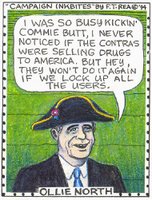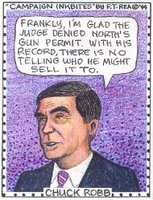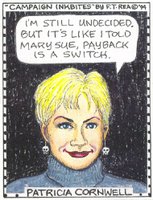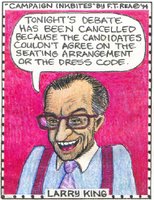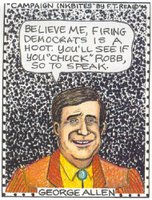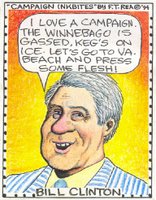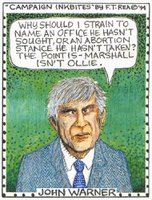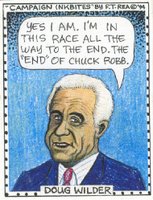 Note:
After attending the memorial ceremony for a friend, a man known to many
of his fans as Eric E., 12 years ago, I wrote the piece that
follows for Richmond.com:
Note:
After attending the memorial ceremony for a friend, a man known to many
of his fans as Eric E., 12 years ago, I wrote the piece that
follows for Richmond.com:
RICHMOND, VA (August 19, 2003): The horns wailed as they entered
the Arthur Ashe Center. At about 12:30 p.m. a brass New Orleans-style
procession playing "Just A Closer Walk With Thee" led the family,
friends and fans of the late L. Eric "Rick" Stanley into the memorial
ceremony.
It was a service for the deejay known to his local listeners as Eric E. Stanley died on August 12, 2003.
The program billed the occasion as a "celebration of life." What
followed the procession, two hours-plus of music and colorful Rick
Stanley anecdotes with a somewhat restrained dose of old-time religion,
lived up to the billing.
Many of the faces in the crowd of approximately 1,500 were familiar
to anyone who has followed the live music scene in Richmond over the
last 20-some years. Interestingly, for a city reputed to be trapped
in habits that separate blacks from whites, Stanley once again
demonstrated his unique ability to appeal to both sides of Broad
Street.
Eric Stanley, who was 53 when cancer took his life, was the host
and producer of the Bebop, Boogie, & Blues Review, a radio show of
his own invention that was heard most recently on WJMO-105.7FM on
Sunday nights. As well, he was a promoter/producer of many live shows.
Stanley's bright-eyed daughter, Erin Stanley, closed her remarks
with her father's trademark radio sign-off: "Gotta go ... gotta go."
Tears flowed – of course they did – but the overall mood in the
room was decidedly upbeat. Stanley's presence was symbolized
throughout the cavernous space by photographs and other traditional
remembrances on display, which included his own harmonica – a Hohner
Pro Harp, a 10-hole diatonic with black cover-plates.
For the recessional the musicians played "When the Saints Go Marching In" to lead the gathering into the sunlight.
Those who were so disposed went to the closest restaurant/bar,
Dabney's, where a lively reception ensued, and lingered. No doubt, it
was a crowd Rick Stanley would have enjoyed being a part of.
His silent black harmonica was there.
*
Note: A year-and-a-half before that ceremony I wrote this profile of Rick Stanley for Fifty Plus, a local magazine.
Eric E: Jukebox of Americana
By F. T. Rea
FEBRUARY 2002: Richmond’s Eric E is a jukebox of colorful anecdotes
about American music. Push any button and out comes another of his
takes on some aspect of the music he has found in his midst. Then you
get a set that might include a mix of Jazz, Blues, Rock ‘n’ Roll,
Rhythm & Blues, Zydeco, Rockabilly, Country & Western, Hip Hop,
Soul, Gospel, or Du-Wop. You name it.
Otherwise known as Eric E. Stanley, Eric E has made a lifelong
study of American working-man’s music styles and the connections
between them. His understanding of those integral connections --
synapses between genres -- lies at the core of his own authentic style.
All that said, Stanley is on the air, again, with a
better-than-ever version of his trademark radio show: the Bebop Boogie
& Blues Revue. He’s back after dodging a bullet that came at him
out of blue -- prostate cancer. After a routine test alerted him to his
situation, he was basically out of the game for a year.
With that ordeal behind him, what comes out of his listeners’
speakers on Sunday nights, between 7 p.m. and midnight, is the Eric E
jukebox of Americana. His free-association decision of what recording
to play next can be as improvised as a jazz musician landing on just
the right note and quirky pause to justify the experimental riff he
just played.
Seamlessly, Eric E moves from Jimi Hendrix to Patsy Cline to Muddy
Waters to Li’l Ronnie and the Grand Dukes to Stanley Turentine, all,
without worrying about why.
In an age of ubiquitous ticky-tacky radio programming, Stanley’s
variety-oriented ideas can’t be packaged into a standard format. Thus,
his current arrangement with WJMO, 105.7FM, allows him to do as he
pleases with the five-hour block of time. He not only hosts the show and
selects the music, but he also arranges for the program’s
underwriting. In effect, Eric E. is his own boss.
The product, the Bebop Boogie & Blues Revue, is an utter
delight. Typical of the Eric E style, he also does the commercials
live. With no canned hype, the ads come off more as endorsements than
intrusions. At this writing, BB&BR’s five sponsorships, one for
each hour, are the Richmond Jazz Society, Plan 9 Music, Kuba Kuba
restaurant, the Commercial Taphouse, and Creole Arts.
“If you advertise with me, I’m going in your business,” says Stanley. “If I haven’t been in the place, I don’t accept the ad.”
The Path to Radio
As a child, Eric Stanley spent as much time as he could at his
aunt’s restaurant, a spacious old log-house with a stone fireplace. The
Hilltop Restaurant, located on US Route 1 in Ashland, catered mostly
to a rural black clientele. In the summer he’d cook hamburgers and do
what he could to seem useful.
The Hilltop featured live entertainment, mostly acts from what was
known as the Chitlin’ Circuit. Down in the basement, Stanley’s uncle
poured off-the-record shots of liquor. Fascinated with the raw music
and the natural scene surrounding it, Ricky -- a skinny kid with
glasses -- soaked up all he could from traveling bluesmen such as Jimmy
Reed and Elmore James.
Sometimes Reed would baby-sit for precocious Ricky (who tended to
ask too many questions) when his aunt and uncle were running errands
for the business. “I remember it from the late '50s to early '60s,”
says Stanley with his easy smile. Of the legendary Reed, Stanley
recalls: “He’d give me a quarter for the vibrating [lounge] chair,
drink whiskey from a little bottle, and play his guitar.”
Stanley’s favorite hit tunes from his childhood? Off the top of his
head he answers, “‘In the Still of the Night,’ ‘It’s All in the
Game,’ and ‘Twist and Shout,’ the Isley Brothers version.”
During his high school days, playing drums and harmonica in bands,
together with performing as a dancing drum major, Stanley leaned that
he enjoyed performing in front of a crowd. That yen would resurface.
In 1968, after Stanley finished Virginia Randolph, he went on to
study advertising at Virginia Commonwealth University for a couple of
years. For the next nine years he was away from the Richmond area, for
the most part, studying Early Childhood Education at Bowie State
College in Maryland and working as a day-care teacher in Washington. It
was during his period in D.C. that he fell into broadcasting.
A friend was hosting a radio program with commentary about prison
life. He helped her with the project and began playing some jazz here
and there to broaden the narrowly focused show’s appeal. That led to
Eric Stanley’s first program of his own, a 2 a.m. to 6 a.m. gig on
WPFW-FM.
Color Radio
In 1979 Stanley returned to Richmond, and in 1982, while managing a
Reggae band, Awareness Art Ensemble, he found his way to Color Radio.
“I got involved with Color Radio because Charles Williams, of the
Good Guys band [bass guitar], called and told me they were starting a
station on Continental Cablevision and I should get involved,” says
Stanley.
Color Radio (1982-84) was the sound heard behind cable television
company’s static color-bar test pattern on Channel 36. The station was
started by alternative music enthusiasts who were, for the most part,
neophyte broadcasters. Some had had experience at college stations.
The sound traveled by phone line from a makeshift studio over Plan 9
record store in Carytown to Continental, which sent the signal out on
its lines. The DJs were invited volunteers -- several were musicians
-- and they essentially played and said whatever they liked.
The eclectic, spontaneous style Stanley developed then is what he
has used when he could ever since. He dubbed his show, “The Frontline
-- 360 degrees of Ba-Lack Music.” Stanley closed each show with what
has become his signature sign-off as Eric E, the performer: “Gotta go …
Gotta go.”
From WANT to WVGO
In the radio business some things change fast, others never change.
One day you’re the toast of the town. The next week your front door
key doesn’t work because the station’s locks have been changed; you’ve
been sacked. Eric Stanley, like anyone who has hung around for any
time in the radio biz, has been buffeted about by a variety of
stations through all sorts of changes in ownership and format.
The story of how he came to his present gig on Sunday nights picks
up in 1988, when WRNL, 910-AM, hired Eric Stanley to host an oldies
midday show. Later, he expanded into Saturday nights, with an
R&B-oriented oldies show.
In 1990 Harriet McLeod, popular music writer for the Richmond News Leader wrote:
Stanley, music director
since January, has set out to make it [WRNL] Richmond’s funkiest radio
station, adding to the oldies format B-sides, album cuts, tunes that
never charted in the era when sales in black-owned record stores, and
often sales of black artists, weren’t counted for the charts. Stanley
draws much of his playlist from a personal collection of 5,000 albums,
singles, tapes, CDs.
His move to WRXL-FM marked the
beginning of the Bebop Boogie & Blues Revue, which Eric E hosted
on Sunday nights. Although it was Blues-based, this time he got the
freedom to do something closer to what he had done with his Color Radio
show. At this point he called his format “free-form.”
Among other things freeform meant taking risks in stride. In
speaking of two of his favorite musicians, Miles Davis and John
Coltrane, Stanley says, “The ones [musicians] who got the most respect
took chances.”
His next move, in 1992, was to WVGO, 106.5-FM. The new station
positioned itself as an alternative to "classic rock" and took the
Richmond market by storm. Soon Stanley was recognized widely for his
amazing crossover success: in other words, a black radio personality
appealing to a white audience. Suddenly he was everywhere; hosting live
events for the station and the darling of local entertainment
writers.
On the air Eric E pushed the envelope, even for a station with a
so-called “alternative” format. In addition to his “almost anything but
opera” style of presentation he made a point of playing the
recordings of local acts, too; such as Boy O Boy, the Good Guys and
Theories of the Old School.
In 1994, having acted as DJ/host of a blues night at Mulligan’s
Sports Bar for five years, he moved his act to Memphis Bar & Grill
in Shockoe Bottom. There he played records and presented live music on
Wednesday night for two years. But in October of 1995 the wind
shifted in the market once again. Eric E and WVGO went their separate
ways. And the next year he moved his live version of Bebop Boogie
& Blues Revue to the Moondance Saloon. At this point he was also
busy doing voice-overs for commercials and acting as a consultant
and/or executive producer for several area bands' recording projects.
Diagnosis and Recovery
Over the years the resourceful Eric Stanley has worked a number of
jobs to fill in and around his show business activities. It was in one
of those situations that he suddenly learned of a totally unexpected
problem. A screening for prostate cancer, conducted through his
workplace, Haley Pontiac, revealed that he had no viable option to
surgery, which took place in July of 2000.
Since this meant no work for a lengthy spell and his insurance was
inadequate to cover all the ramifications, money problems loomed, not
to mention the natural worry about his prognosis. Although these were
dark days, there was a shaft of light at the end of the tunnel.
Enter two friends: Marilyn Marable and Lee Pillsbury. Overnight
they organized a benefit show at Alley Katz, a Shockoe Bottom live
stage. The all-star lineup included; Plunky & Oneness, Rene Marie,
Jazz Poets Society, Bio Ritmo, The Deprogrammers/Good Guys (a
combination of the two bands), Car Bomb, Inc., The Nighthawks, Helel,
and Fighting Gravity.
Of the night of the Alley Katz extravaganza, Stanley says: "The most humbling thing was when they put that benefit on."
Today, cancer free and undergoing no cancer-related treatment, he
laughs at an unflattering photograph of a somewhat wan-looking Eric E
that accompanied an article about the benefit. "When I saw that picture
of me I thought I was dying."
Since then the American Cancer Society has approached him about
acting as a spokesman for the organization, speaking to groups of men
on the importance of testing.
“Since I’m exercising and eating better, I may be healthier than I
was,” says the ever upbeat Stanley. “Last year, I was diagnosed and
treated for cancer. Thanks to God, a real good woman [the previously
mentioned Marilyn Marable], a good doctor, and the mojo [a green bag of
mysterious herbs, bone powder and who-knows-what? he picked up in New
Orleans years ago] I keep in my pocket, I'm still here and laughing
at you."
Sunday Night Live
Now that Eric E is back in the saddle, the last Arbitron ratings
book [as of this writing] reported that the Bebop Boogie & Blues
Revue had already shot to a close second to WCDX-FM, Power 92, in his
time-slot, among listeners in the 25-to-54 demographic.
So instead of complaining about how lame radio in Richmond can be,
the reader is advised to tune in to Eric E for an escape from the
ordinary. On top of its entertainment value, his show is not unlike a
class in music history. Yes, Stanley sounds very much the professor as
he explains, for example, how Muddy Waters put together the
traditional electrified blues ensemble of two guitars, drums and
harmonica, with piano on occasion.
In fact, Professor Eric E is teaching a class, American Music:
Blues, Hip Hop, Jazz, and Rock 'n' Roll, at St. Catherine’s School this
semester. So the young ladies on Grove Avenue, nestled up to the
Country Club of Virginia, are learning how Chuck Berry took Country
& Western songs and gave them a Blues shuffle-beat in order to
become a Rock ‘n’ Roll pioneer.
Those private school students will also be exposed to Eric E.
Stanley’s well-honed thoughts on the power of music to reach across
cultural barriers. Of music’s ability to bring people of different
backgrounds together he says: “Many times it’s the hammer that breaks
the wall down.”
From the Hilltop Restaurant, by way of countless hours of
platter-spinning air-time, Eric Stanley, 52-years-old on February 26 (a
birthday he shares with music legends Fats Domino and Johnny Cash),
is at the top of his game, again.
Meanwhile, as the former hamburger flipper and dancing drum major would no doubt say at this point, “Gotta go … gotta go.”
-- 30 --
-- Photo by Al Wekelo















